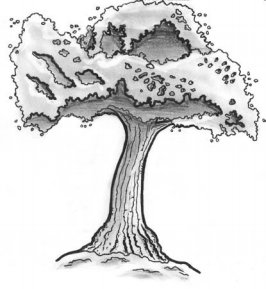Activity 1.3.6 Problem-Solving Tree
- Purpose
- To develop problem-solving techniques
- Materials
- Large sheets of white paper (or use handout on next page),
coloured markers
- Time
- 1–2 hrs
Method

- Give participants the tree diagram handout or
show it as an example on an overhead projector
and explain how it can be used for analyzing a
problem. (See handout on next page.)
- Ask participants for examples of global
problems, e.g., pollution.
- Show how the tree diagram can be used to look
at the problem of pollution. Facilitators can use
the following explanation: the trunk is the
problem, the roots are the origins or causes of
the problem, the leaves and branches are the
effects on people’s lives, and the watering can
represent strategies to solve the problem. (You
will have to draw in the watering can.)
- As a group, brainstorm and record on the
diagram the causes and effects of the problem.
- Next, divide the class into three groups to brainstorm and write down solutions. Give groups
about 15–20 minutes to analyze and come up with solutions.
- As a whole group, discuss how difficult or easy it was to find solutions.
- Instruct participants to now find an area in the room where they can work on their own.
- Ask them to use this tool to help solve a personal problem. Allow about 30–45 minutes to
complete the task.
Participants can share their problem-solving trees if they wish.

